Invented by Hyung Suk Kim, Young Sam Park, Hun Joo Hahm, Jung Kyu Park, Young June Jeong, Samsung Electronics Co Ltd
LCDs are widely used in various electronic devices such as televisions, computer monitors, smartphones, and tablets. These displays require a backlight unit to illuminate the screen and enhance the visual experience for users. The backlight unit is a critical component that ensures optimal brightness, contrast, and color reproduction in LCDs.
One of the key drivers of the backlight unit market is the increasing adoption of LCDs in the consumer electronics industry. With the rising popularity of smart devices and high-definition displays, manufacturers are constantly striving to improve the visual quality of their products. This has led to a surge in demand for advanced backlight units that can deliver superior image quality and energy efficiency.
Another factor contributing to the growth of the backlight unit market is the rapid expansion of the automotive industry. LCDs are now widely integrated into vehicle dashboards, infotainment systems, and rear-seat entertainment displays. These applications require backlight units that can withstand harsh operating conditions, including extreme temperatures and vibrations. As the automotive industry continues to evolve towards autonomous and electric vehicles, the demand for LCDs and their associated backlight units is expected to increase further.
Additionally, the healthcare sector has emerged as a significant consumer of LCD displays and backlight units. Medical devices such as ultrasound machines, patient monitors, and surgical displays rely on high-quality LCDs to provide accurate and detailed visual information. The backlight units used in these applications must meet stringent regulatory requirements and deliver consistent performance over extended periods.
Furthermore, the growing trend of miniaturization in electronic devices has also fueled the demand for compact and efficient backlight units. Manufacturers are constantly developing innovative backlight technologies, such as edge-lit and direct-lit LED backlight units, to meet the requirements of slim and lightweight devices.
The market for backlight units for LCDs is highly competitive, with numerous players vying for market share. Key players in the industry are investing heavily in research and development to introduce new and improved backlight technologies. They are also focusing on strategic partnerships and collaborations to expand their product portfolios and reach a wider customer base.
In conclusion, the market for backlight units for liquid crystal displays is witnessing robust growth driven by the increasing adoption of LCDs in various industries. The demand for high-quality backlight units that offer superior image quality, energy efficiency, and durability is on the rise. As technology advances and consumer expectations continue to evolve, manufacturers will continue to innovate and develop cutting-edge backlight solutions to meet the demands of the LCD market.
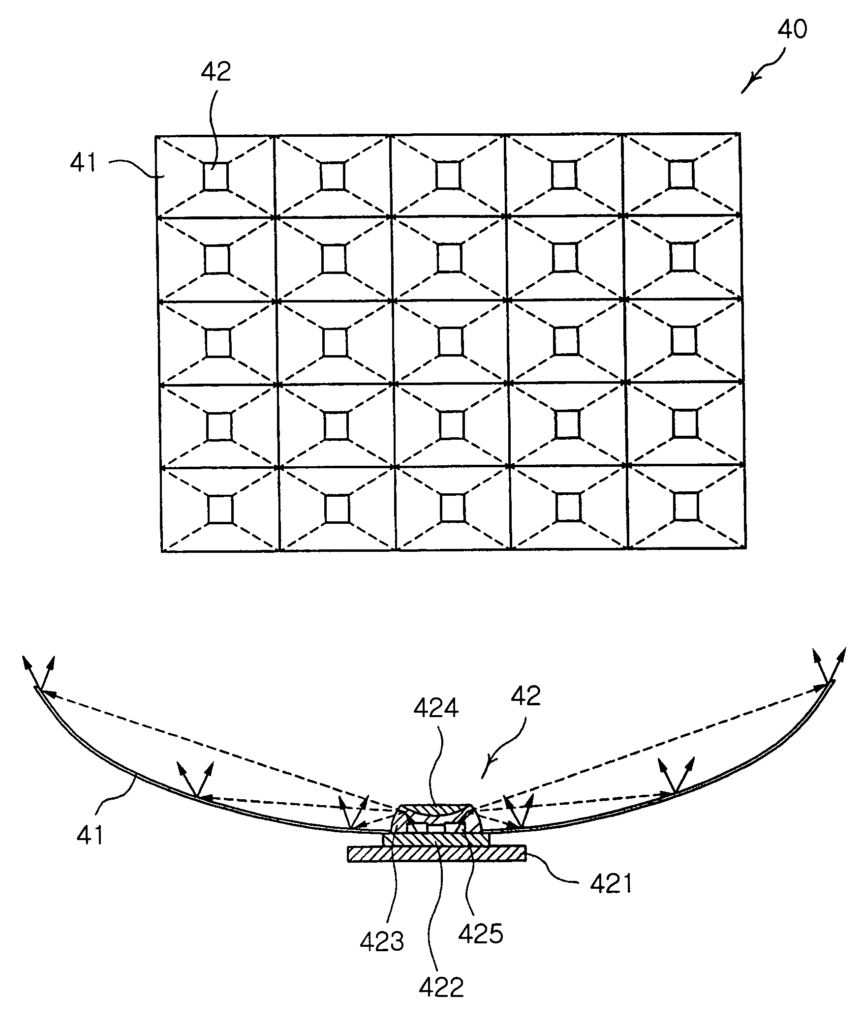
The Samsung Electronics Co Ltd invention works as follows
A backlight of a liquid-crystal display comprises a number of light emitting packages that are arranged in a grid and spaced uniformly apart. Each light-emitting diode pack includes one or multiple light-emitting diode chip and is designed so that the light generated by the light emitting chip is emitted horizontally. Reflectors are made up of a number of cells that are connected in a matrix. “Each of the unit-sized reflection cells has each of its light generating packages at its center, and reflects light from the light emitting device at its center in both the horizontal and vertical directions.
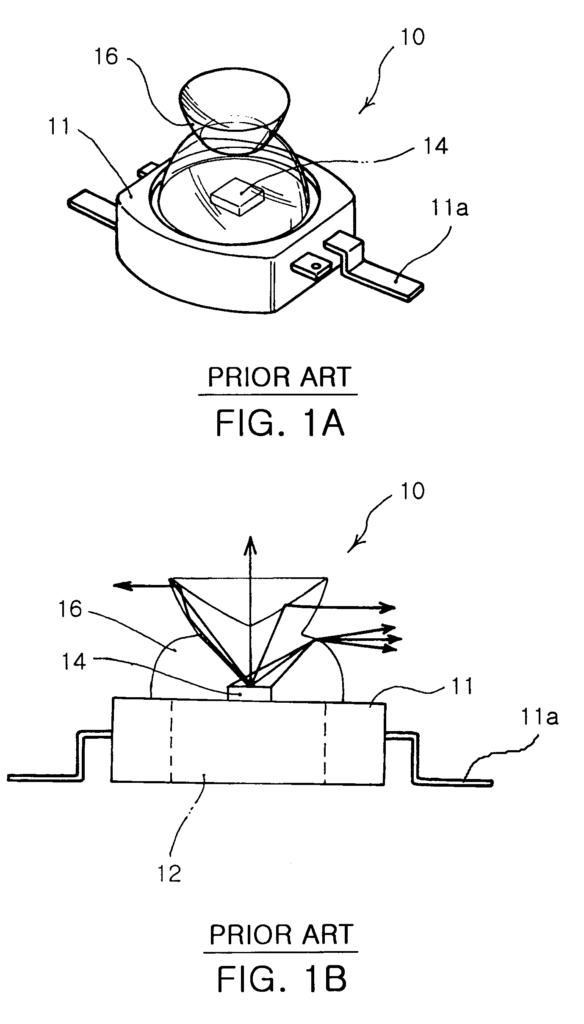
Background for Backlight unit for liquid crystal display
1. “1.
The present invention is a backlight of a LCD, more specifically a unit that can be used with a lower number of light emitting devices. It has a common structure applicable to LCDs of any size.
2. “2.
The light emitting diode is a semiconductor device that emits light in various colors. Its light source can be made up of compound semiconductors such as GaAs and AlGaAs. Other materials include GaN, InGaN, AlGaInP, GaN or AlGaInP. The LEDs are now more versatile with the introduction of three primary colors (red blue green) and a white LED, which is made from nitride, a material that has excellent physical and chemical characteristics. The LEDs can be used for a variety of applications such as the backlighting of a keyboard or liquid crystal display, as a signal light, or even a guide lamp on an airport landing strip. They are also useful in street lighting and other similar situations.
As a standard to determine the characteristics of LEDs, the colors, brightness, light intensity, and similar, can be used. These are determined by the compound semiconductor material for the LEDs and, secondarily, by a package for mounting the LED chips.
FIGS. “FIGS.
Referring to FIGS. “Referring to FIGS.
The lens 16 is a semi-spherical pyramidal shape that acts to refract the light from the LED chip 14, located in the middle of the top surface of the frame 11, to the horizontal direction.
The package structure consisting the frame 11 with the lens 16 is designed such that light emitted from the chip 14 is approximately horizontal, while heat generated by the chip 14 can be dissipated outside. This provides stable operation characteristics for the LED device 10.
The LED device 10 shown above is a source of spot light. To realize surface emission using the spot light sources, it is necessary to have a separate structure. In this regard, a structure has been provided whereby an LED array with multiple LED devices 10 in a row is mounted at the middle of a semi-cylindrical reflection plate. This allows surface emission to be realized through the reflective plate.
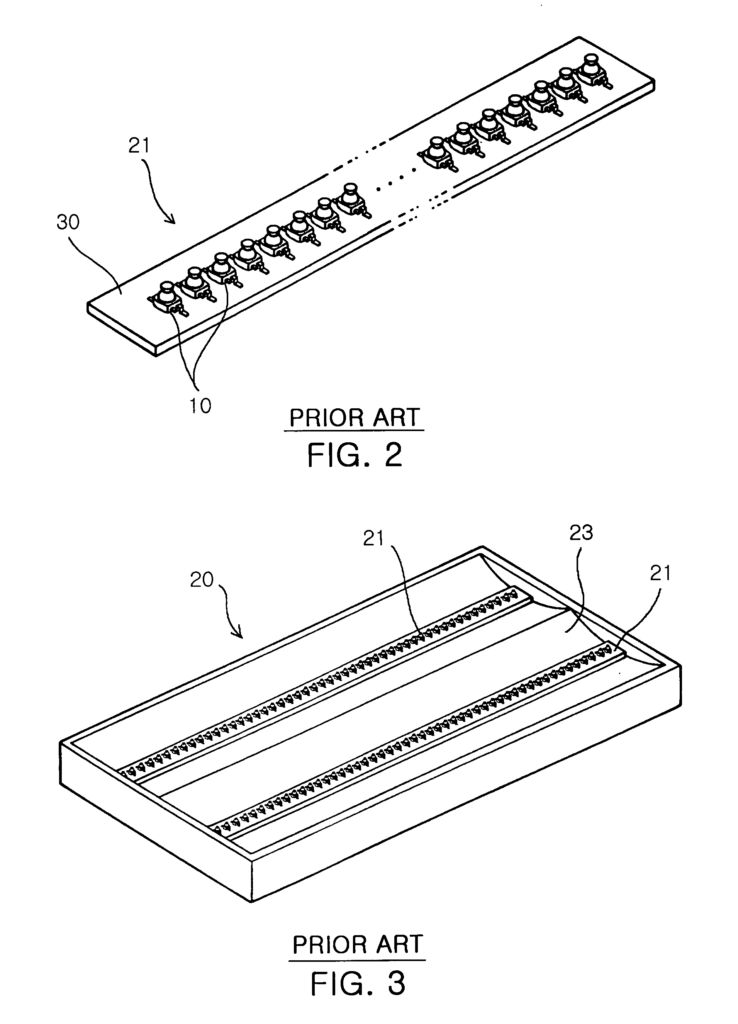
FIG. “FIG. The LED array 21 is shown in FIG. 2.
As shown in FIGS. The backlight unit 30 includes: as shown in FIGS. The LED array module 20 emits one color from red, blue, and green. A printed circuit board 21 has printed circuit patterns to transmit an electrical signal thereon, and is used for mounting the plurality LED devices 10 on the PCB in a row so that three colors are alternately emitted. The array module’s PCB 30 is made from Al which has a good thermal conductivity to improve heat dissipation.
The backlight unit 30 achieves surface emission on all ranges of a LCD screen, by reflecting the light emitted in the horizontal and perpendicular directions from the respective LED devices, mounted on the LED array 20.
The number of LED array modules required for the unit with the above-described structure is proportional to the size of the LCD screen that uses the LED modules. The number of LED devices 10 that are required for each LED array module 20 also increases in proportion to screen size.
The conventional backlight unit is a problem because the LED array module and the reflective plate must be redesigned to fit the LCD screen. Also, the number of expensive LED devices 10 increases in proportion to LCD screen size.
The LED devices 10 emit three colors, but since they are individually packaged and mounted on the PCB 21, the power is applied separately to each of them. This results in the three colors being mixed outside. In order to mix three colors from LED devices 10 properly, it is necessary for a mixing space to be provided, which results in a thick LCD screen.
Furthermore, because the LED devices 10 have been linearly arranged, the length of the LED module is determined by the size of the LCD screen. As the screen size increases, the number of LED devices 10 in one LED array 20 also increases. The expensive aluminum PCB 21, however, is also larger. The conventional LCD is inefficient in terms of manufacturing costs and the LED devices are not widely applicable because additional PCBs are required to match the size of the LCD.
Furthermore, the conventional LED device 10 refracts the light in the horizontal using the difference in refraction rates between the lens 13 and the other media. Due to the fact that the light from the center LED to the upper portion is not changed in direction, it can cause a hotspot at the center. A shadow sheet must be used for the backlight 30 to avoid this. The conventional backlight unit is also not competitive in price because it uses a structure of 1 chip per package, whereas the LED device only packages one chip.
The present invention was made to address the problems mentioned above. Its object is to provide a liquid-crystal display backlight that has a common structure applicable to all sizes of liquid-crystal displays and which can be constructed with a lower number of light emitting devices.
According to one aspect of this invention, these and other objects are achieved by a backlight of a liquid-crystal display that includes: a number of light-emitting diode packs arranged in a grid while being separated uniformly from each other; each light-emitting diode pack including one or multiple light-emitting diode chip and structured so that the light generated from those chips is emitted horizontally; and a reflective unit consisting of several reflection cells interconnected in a
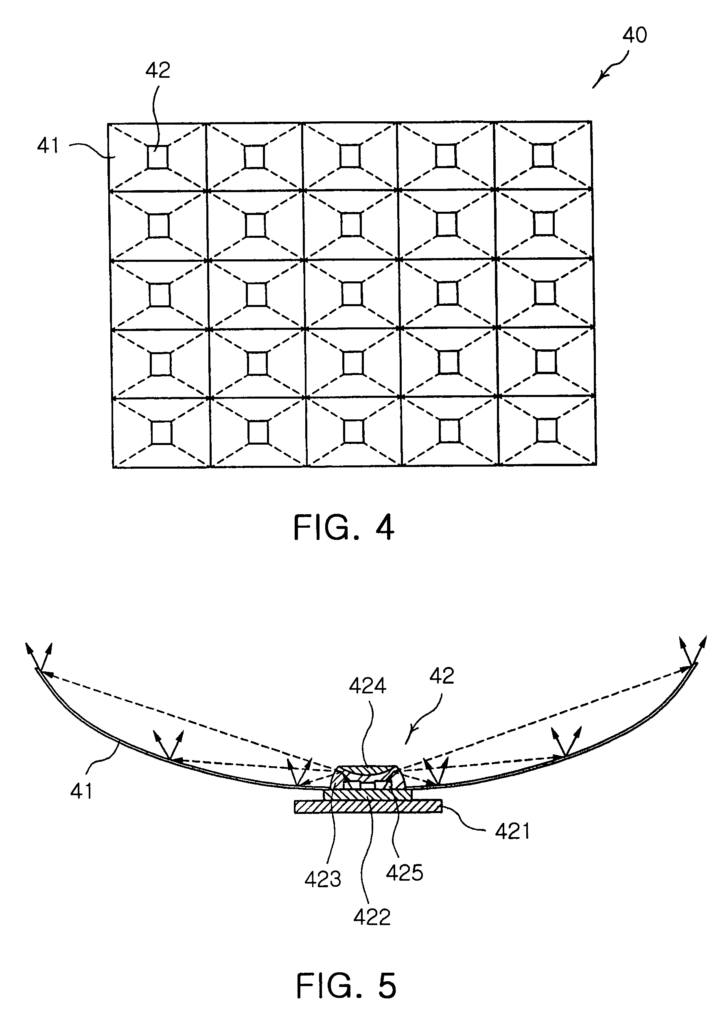
Further,” each of each of reflection cells of the reflector can be formed with a hole of a predetermined diameter at its center, and the light emitting package may be inserted in the hole.
Click here to view the patent on Google Patents.
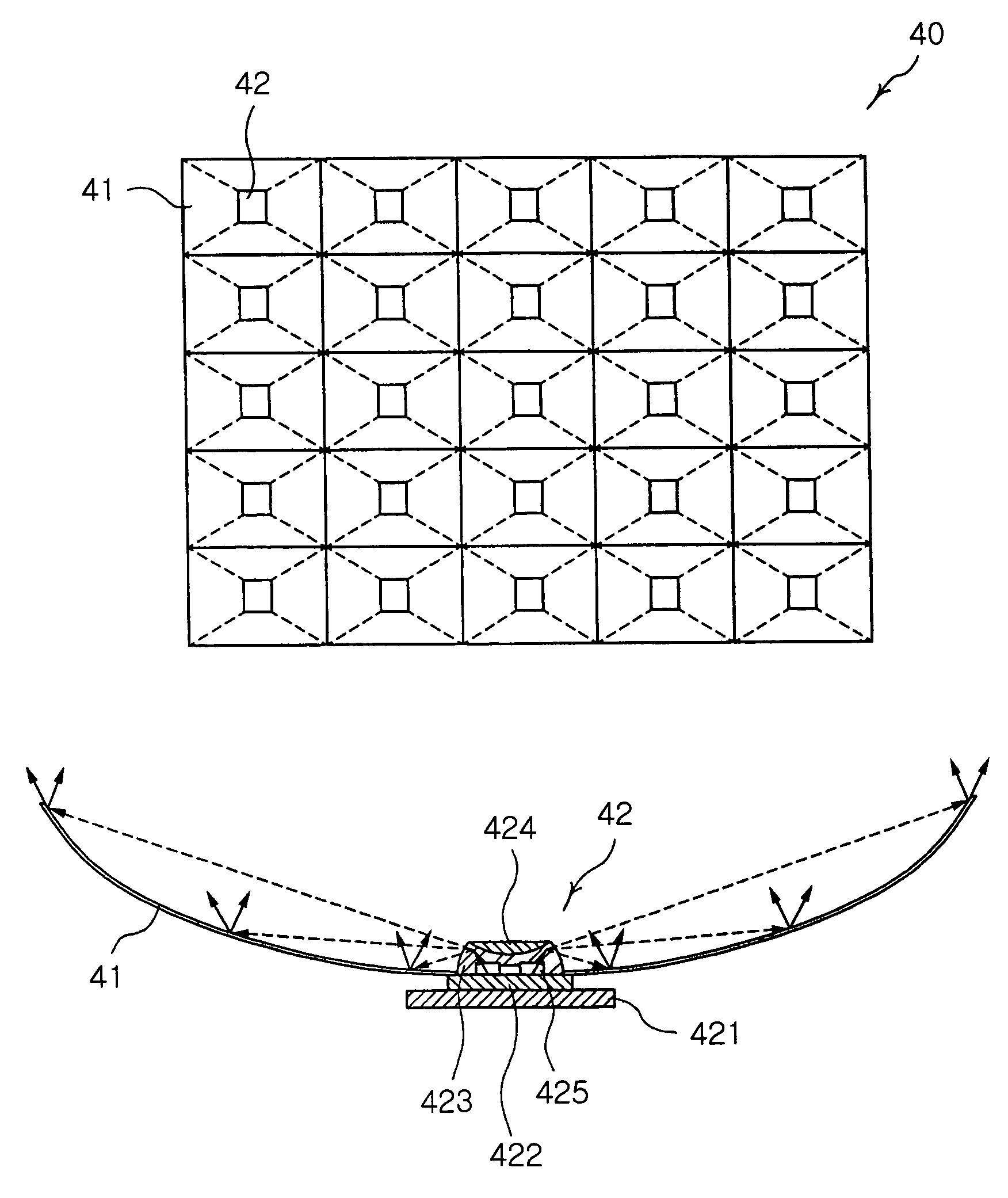
Leave a Reply